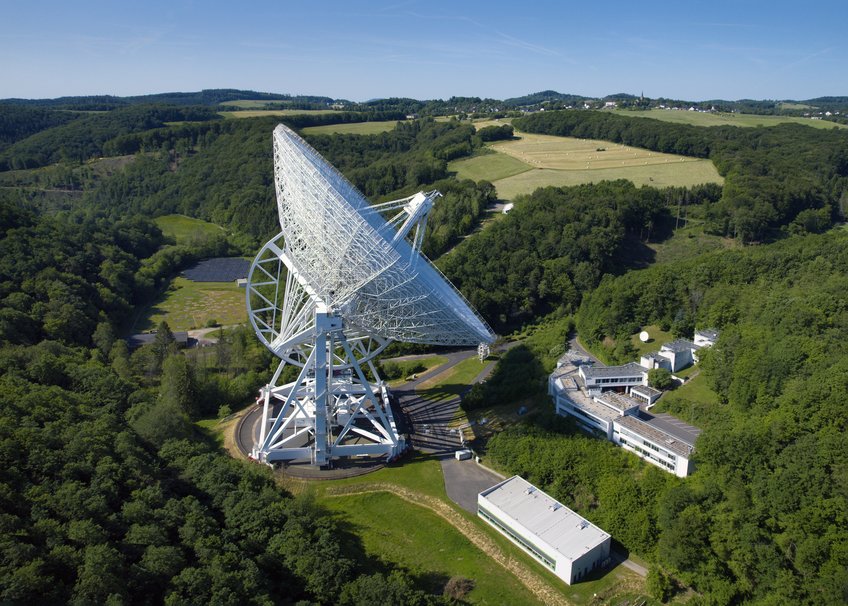World Radiocommunication Conference puts radio astronomy on the agenda
New studies to improve the protection of radio astronomy measurements from satellite systems
Thousands of delegates from the member states of the International Telecommunication Union, industry and scientific institutions such as the Max Planck Institute for Radio Astronomy in Bonn spent four weeks at the World Radiocommunication Conference in Dubai deciding which application is entitled to which share of the radio spectrum. This also involved the protection of radio astronomy, in particular from the radiation of new satellite constellations such as SpaceX's Starlink. Studies are now to be carried out before the next radio conference in 2027. The aim is to develop new regulations and technical measures so that radio astronomy can continue to explore the secrets of the universe as undisturbed as possible in the future.

"Considering that radio astronomy is a pivotal scientific discipline that plays a crucial role in unraveling the mysteries of the cosmos" - these are the opening words of a new resolution of the International Telecommunication Union (ITU, which was adopted on 15 December 2023 at the World Radiocommunication Conference in Dubai. The resolution calls on the member states to develop technical and regulatory solutions by the next conference in 2027 in order to better protect the frequency spectrum used by radio astronomy and to preserve existing protection zones for radio observatories. In particular, this involves protection against artificial interference from satellite constellations from space. For Benjamin Winkel and Gyula Józsa, this is a success. They are responsible for frequency protection issues at the Max Planck Institute for Radio Astronomy, but also represent the interests of the European Commission of Experts for Spectrum Management in Radio Astronomy (CRAF) at the World Radiocommunication Conference and work closely with colleagues from the Square Kilometre Array Observatory (SKAO). "This is still a lot of work for the radio astronomers involved," says Gyula Józsa. "But we are very confident because we have already done a lot of the necessary preparatory work together with our colleagues," adds Benjamin Winkel.
"Radio waves don't stop at national borders"
World Radiocommunication Conferences take place every 3 to 4 years. Thousands of delegates from the member states, in particular the telecommunications authorities (in Germany: the Federal Network Agency), as well as other interest groups from industry, business and science meet for four weeks to work on the so-called Radio Regulations. This is an international treaty intended to regulate the smooth interaction of all radio services. "Radio waves don't stop at national borders," says Benjamin Winkel. If, for example, new mobile radio frequencies are to be made usable, dozens of technical studies have to be carried out beforehand to ensure that existing applications are not disrupted. Radio astronomy is one such application, and a very sensitive one at that. The radio signals that astronomers receive from space are generally very weak compared to man-made radio radiation. If the frequencies of both radiation sources overlap, astronomical observations could become useless.
The radio spectrum, i.e., the entirety of all radio frequencies available for radio transmissions or measurements, is already in full use. Certain frequency ranges are also reserved for radio astronomy in order to protect particularly important observation projects. "However, these frequencies are far too few for modern radio astronomy," reports Gyula Józsa. "This is also the reason why the 100-metre radio telescope of the Max Planck Institute for Radio Astronomy was built in a valley in the Eifel and not in the centre of Bonn. It is well shielded in the Eifel". Of course, the new satellite systems, such as SpaceX/Starlink, OneWeb or Amazon/Kuiper, cannot be avoided in this way. After all, the aim of these companies is to provide Internet access everywhere on Earth.
Protection of large-scale radio observatories worldwide

From a European perspective, this particularly affects the two large international observatories, the Atacama Large Millimetre/submillimetre Array (ALMA) with telescopes in Chile and the Square Kilometre Array Observatory (SKAO) with telescopes in South Africa and Australia. Astronomical institutes and organizations worldwide are investing billions in these observatories. The Max Planck Institute for Radio Astronomy in Germany has been involved in ALMA and the SKAO via the design of receiver systems. For South Africa and Chile, however, these ventures also play a strategic role in the nations’ development. They are infrastructure measures, educational institutions and places of international cooperation all in one. Developing countries have only been involved in the International Telecommunication Union, which has been in existence since the 1860s, since 2006. "Ideally, the industrialized countries' 156 years of experience should support the needs of developing countries and not hinder them," says Busang Sethole from the South African Radio Astronomy Observatory.
The fact that the needs of astronomers were addressed at all at the World Radiocommunication Conference was only possible because two important regional organizations had declared the topic a top priority in the run-up to the conference. One was the European Conference of Postal and Telecommunication Administrations (CEPT), which wanted to see the already existing protection criteria for radio astronomy better enforced. The second was the African Telecommunications Union (ATU), which has brought the issue of special radio quiet zones to the international stage. These zones are areas in which terrestrial radio equipment is restricted in the vicinity of observatories in order to create better observation conditions. However, these are purely national regulatory interventions and cannot influence satellite systems, which are subject to international rules.
BW, NJ, BEU













